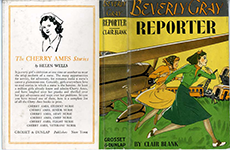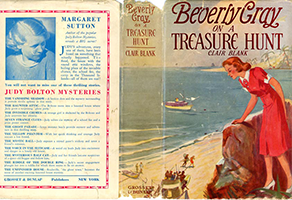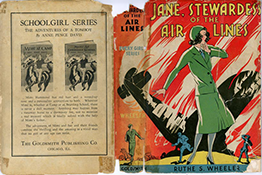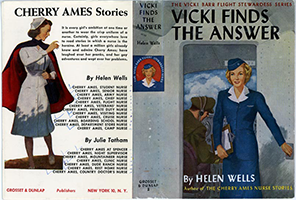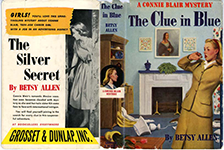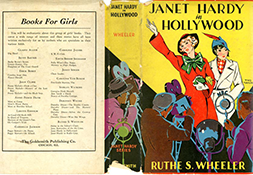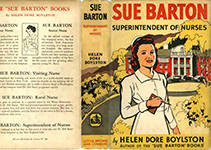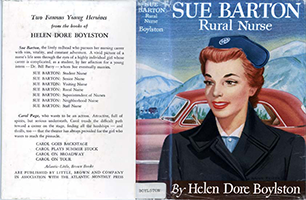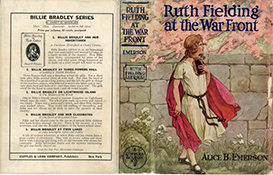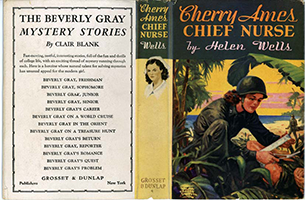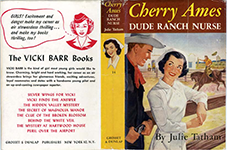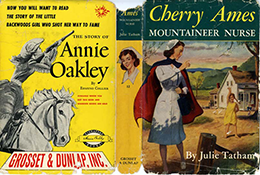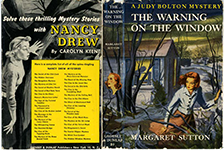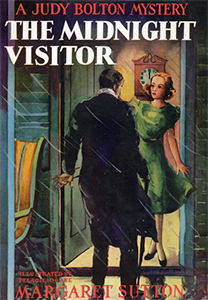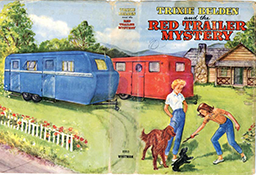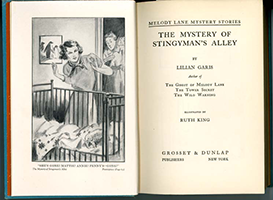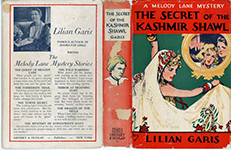Other Girl's Series Books
Help Wanted: Female Looking for Adventure, Mystery and Glamour!
Although the careers may vary, the heroines of the girls’ series regularly find time to solve mysteries and have adventures while maintaining their fashionable looks. For most of the career girls, their jobs merely supply an excuse to visit exotic or quaint locales that provide a scenic backdrop to the mysteries that they inevitably encounter in the course of their work and travels.
These enterprising young women gain independence from their close knit families by leaving their small town homes to pursue exciting new careers in the big city. Some, like Beverly Gray and Vicki Barr, first attend college or a professional training program, where they meet new friends who will accompany them on future adventures. Although most of the girls attract male admirers, romance generally does not play a significant role in the lives of these busy heroines.
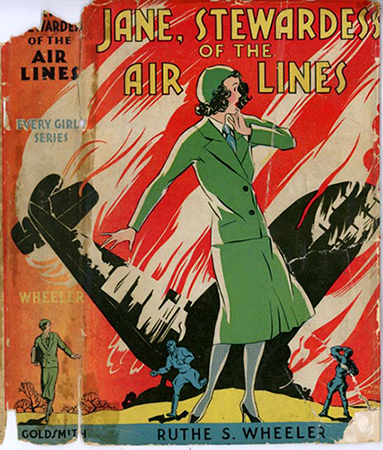
Beverly Gray
World Traveler
Journalist Beverly Gray is an exemplar of the well-traveled career girl who leaves her small town home behind.
Blank, Clair. Reporter. New York: Grosset & Dunlap, 1940.
Beverly Gray and Susabella
After a stint in New York City, Beverly and her friends spend several volumes aboard the yacht “Susabella” whose ports of call include such exotic ports-of-call as Egypt, India, Japan and China, where she is abducted by cannibals on an unnamed island while On a Treasure Hunt.
Blank, Clair. Beverly Gray on a Treasure Hunt. New York: Grosset & Dunlap, 1938.
Vicki Barr and Jane Cameron
Excitement in the Skies
The bold and daring exploits of Jane Cameron and Vicki Barr in the heady early days of commercial air travel were contrived primarily for entertainment value. However, both characters introduced young girls to a potential new career as the jacket copy of Jane, Stewardess of the Airlines proclaimed: “Air travel has created an entirely new profession of girls...”
Wheeler, Ruthe. Jane, Stewardess of the Airlines. Chicago: Goldsmith, 1934.
Stewardesses
Hopefully the average air stewardess’s career would be less eventful than Jane’s who survived a crash landing in Nebraska and airborne attack by sinister “air bandits” in the one and only book of The Every Girl’s Series that featured her. Vicki Barr faced similar perils, as each flight found her embroiled in perplexing and dangerous situations.
Wells, Helen. Vicki Finds the Answer. New York: Grosset & Dunlap, 1947.
Connie Blair
Teenage Career Girl
This series chronicles the escapades of “teen-age career girl” Connie Blair who works at the Reid and Renshaw advertising agency, where her detective skills also come in handy. Betty Cavanaugh, the well-known author of juvenile fiction, wrote volumes 1-11 under the pen name Betty Allen.
Allen, Betsy. The Clue in Blue. New York: Grosset & Dunlap, 1948.
Actresses
Acting was another fashionable career choice for girl’s series heroines and as with the other careers it served as an excuse to place the young protagonists in exciting and dramatic locations where mysterious events occur. Typically, as in most of the career girl series books, the aspiring actresses landed jobs with relative ease and only suffer a few minor setbacks.
Wheeler, Ruthe. Janet Hardy in Hollywood. Chicago: Goldsmith, 1935.
Nurses
Nursing was a popular profession for girls’ series’ leading characters, particularly during the first half of the twentieth century. One of the earliest examples in this genre appears midway through the Ruth Fielding series when the title character volunteers as a nurse in World War I. Sue Barton was a popular and well written nursing series published between 1936 and 1952.
The U.S. involvement in World War II prompted the publication of several girls’ books and series devoted to nurses. Begun in 1943, the Cherry Ames Nurse series, one of the most popular series, not only provided wholesome entertainment for adolescent girls, but also incorporated the patriotic message that young women could play an active role in the war effort both in the battlefield and on the home front.
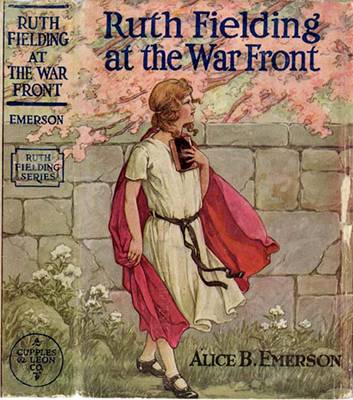
Sue Barton
The author of this series, Helen Dore Boylston, attended Massachusetts General Hospital School of Nursing and served as an anesthesiologist with the British Expeditionary Force in World War I.
Boylston, Helen. Sue Barton: Superintendent of Nurses. Boston: Little, Brown and Company, 1940.
Barton's Career
Considering that the author once served as a nurse in World War I, it is somewhat ironic that her main character is one of the few fictional nurses during this period who did not serve in the war. This was most likely due to the fact that the Sue Barton was already married with one small child by 1940. Instead the series documents the evolution of the title character from unsure student to capable nurse, doctor’s wife and mother of four.
Boylston, Helen. Sue Barton: Rural Nurse. Boston: Little, Brown and Company, 1939.
Ruth Fielding
While she is not a nurse for most of the series, Ruth Fielding volunteers as a Red Cross nurse during World War I and serves in France. Ruth Fielding in the Red Cross and Ruth Fielding at the War Front, which were published in 1918, feature her nursing experiences.
Emerson, Alice B. Ruth Fielding at the War Front. New York: Cupples & Leon, 1918.
Cherry Ames
The Patriotic Nurse
"The Army Nurse, trim and neat in her uniform greeted the graduates....A note of urgency crept into her voice as she pleaded with them to answer their country’s call. “You are needed, desperately needed! If we are to save our men out there fighting for us—if we are even to win this war—you nurses must help. Are you ready to serve?" —from Cherry Ames, Senior Nurse
Wells, Helen. Cherry Ames: Chief Nurse. New York: Grosset & Dunlap, 1944.
A New Military Nurse
The series begins with Cherry’s years in nursing school where upon graduation, she along with her entire class, decides to join the Army after hearing the impassioned plea of the Red Cross Army nurse. The following three books, Army Nurse, Chief Nurse, and Flight Nurse give an authentic portrayal of the training that a new military nurse preparing to go overseas would require.
Tatham, Julie. Cherry Ames: Dude Ranch Nurse. New York: Grosset & Dunlap, 1953.
Eternally Young
The series continued well after the war, as Cherry pursued her nursing career in such unusual locations as dude ranches, department stores, cruise ships and ski resorts. As a girl series heroine Cherry was not allowed to age. Thus, her years as an Army nurse were never referred to in the post-World War II books so as not to date the eternally young heroine.
Tatham, Julie. Cherry Ames: Mountaineer Nurse. New York: Grosset & Dunlap, 1951.
Judy Bolton and Other Girl Detectives
Not all girl detectives were as perfect as Nancy Drew. Among the sleuths depicted on a more human scale were Judy Bolton, Trixie Belden, and Carol Duncan of the Melody Lane series. Nancy Drew has the freedom and the money to act independently and do as she pleases. These other girl sleuths attended school, worked around the house or at a job, and coped with the restraints of a more traditional family situation.
Judy Bolton solves riddles and problems and exposes secrets, but she must cope with family responsibilities and her own limitations. Likewise, Trixie Belden must struggle with her math homework, chores, and obnoxious brothers. Judy and Trixie are not the heroic figures that Nancy Drew is, but they are appealing because they are realistic and believable.
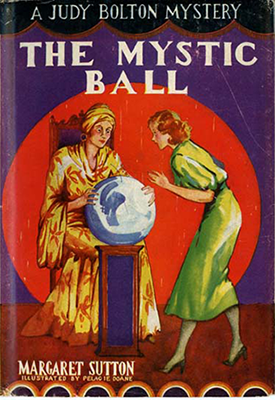
Judy Bolton
Unlike typical girls’ series books, The Judy Bolton series by Margaret Sutton was based on actual locations in Potter County, Pennsylvania; markedly different from Nancy Drew. Judy grew up and married as the series progressed. The back cover of the books often advertised that the mysteries were often based on actual events that occurred in Pennsylvania—such as the dam collapse in the first book in the series, The Vanishing Shadow. Farringdon, the main town in the books, is based on Coudersport, Pennsylvania.
Sutton, Margaret. The Warning on the Window. New York: Grosset & Dunlap, 1949.
Judy's Sidekicks
Spooky old houses figure prominently, and mysteries often involve reuniting relatives. Judy is aided in her sleuthing by her brother Horace, her childhood friend Peter (whom she eventually marries), and his sister Honey. Judy’s black cat Blackberry has a prominent role in the books; he actually helps her solve mysteries and saves lives.
Sutton, Margaret. The Midnight Visitor. New York: Grosset & Dunlap, 1939.
Sutton, Margaret. The Mystic Ball. New York: Grosset & Dunlap, 1934.
Trixie Belden
Trixie Belden is a 14 year old girl detective who lives at Crabapple Farm near Sleepyside-on-the Hudson, New York with her parents and three brothers. She and her friends form a club called the Bob-Whites of the Glen. The first books of the series were written by Julie Campbell Tatham, who also wrote the Ginny Gordon series and many of the Cherry Ames and Vicki Barr books.
Campbell, Julie. The Red Trailer Mystery. Racine: Whitman, 1950.
Melody Lane
Melody Lane is not the name of the heroine of this series; it refers to the street where girl-sleuth Carol Duncan and her family and friends live. The series of nine books were written by Lilian Garis and were published by Grosset and Dunlap from 1933 to 1940.
Garis, Lilian. Stingyman’s Alley. New York: Grosset & Dunlap, 1938.
Hard Times
Unlike most other series books, this series emphasizes the hard times of the Great Depression and depicts the money problems of the characters. For instance, Carol Duncan loses her job playing the organ at the theatre because the new movies were no longer silent. She needs to find another job to support the family while her father is out of work.
Garis, Lilian. The Secret of the Kashmir Shawl, New York: Grosset & Dunlap, 1939.


